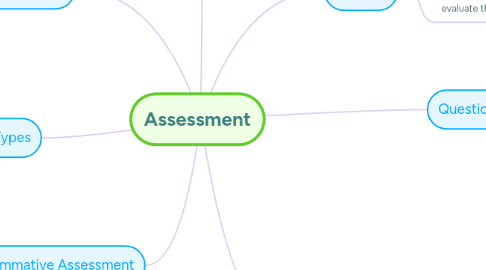
1. Summative Assessment
1.1. Planning
1.1.1. End of a large chunk of learning, review what you want to do, criteria for ensuring high-quality assessment, representative sampling.
1.1.2. Examples: standardized testing, final exams, major cumulative projects, research projects...
1.2. Preparing Students
1.2.1. Teach assessment taking skills, test length, format, types of questions, and review.
2. Delivery Types
2.1. Paper and pencil, online, or computer adaptive testing
3. Scoring Types
3.1. Human scoring, distributed scoring, automated scoring, rubric, checklists
4. Definition
4.1. Assessment is the shared process of gathering purposeful and systematic measurement for documentation, reflection, and improvement of both student learning and institutional practices.
5. Purpose
5.1. Assessment helps students learn, teaches improve instruction, administrators decide how to allocate resources, and policymakers evaluate the efficacy of education programs
6. Formative Assessment
6.1. Process of gathering evidence of student learning, providing feedback and adjusting instruction, teacher-student interaction
6.1.1. Informal Formative
6.1.1.1. Observation, questioning, spontaneous, immediate feedback
6.1.2. Formal Formative
6.1.2.1. Quizzes, planned activity, pre-assessments
6.1.2.2. 6 types: Structured exercises, pretests, homework,in class assignments, unit tests, classroom response systems
6.1.3. Feedback
6.1.3.1. Goal-directed, scaffolding, self-referenced, standards-referrenced, and norm-referenced.
6.1.3.2. Differentiated feedback: learner level of ability, grade level, and subject
6.1.3.3. Effective feedback: Relates to performance to standards and performance to strategies, indicated progress and corrective action, it is specific and focuses on errors.
6.1.4. Mastery Learning
6.1.4.1. Further reading, individual tutoring, group work, questioning, work sheets, peer tutoring, clarifying criteria, modeling, changing sequence, online exploration and concept mapping

